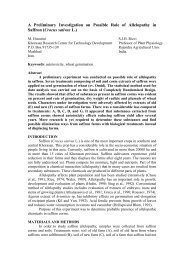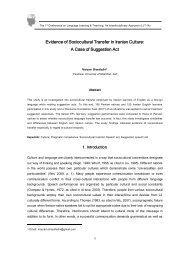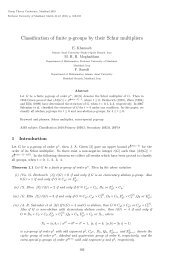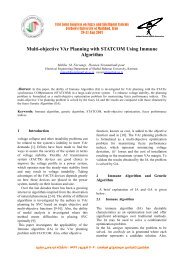Performance-based design in earthquake engineering
Performance-based design in earthquake engineering
Performance-based design in earthquake engineering
You also want an ePaper? Increase the reach of your titles
YUMPU automatically turns print PDFs into web optimized ePapers that Google loves.
5 th National Congress on Civil Eng<strong>in</strong>eer<strong>in</strong>g,<br />
May 4-6, 2010, Ferdowsi University of Mashhad, Mashhad, Iran<br />
<strong>Performance</strong>-<strong>based</strong> <strong>design</strong> <strong>in</strong> <strong>earthquake</strong> eng<strong>in</strong>eer<strong>in</strong>g<br />
Mansour Bagheri 1 ,Mahmoud Miri 2<br />
1-M.Sc Student,Dept. of Civil Eng<strong>in</strong>eer<strong>in</strong>g, University of Sistan and Baluchestan<br />
2-Assistant Professor,Dept. of Civil Eng<strong>in</strong>eer<strong>in</strong>g, University of Sistan and Baluchestan<br />
mnsrbagheri@gmail.com<br />
Mmiri@hamoon.usb.ac.ir<br />
Abstract<br />
The <strong>design</strong> objectives <strong>in</strong> current build<strong>in</strong>g codes address life safety, control damage <strong>in</strong> m<strong>in</strong>or and moderate<br />
<strong>earthquake</strong>s, and prevent collapse <strong>in</strong> a major <strong>earthquake</strong>. However, the actual reliability of the <strong>design</strong> <strong>in</strong><br />
achiev<strong>in</strong>g the objectives is not known. There is a general agreement among researchers and professionals that<br />
future seismic <strong>design</strong> needs to be <strong>based</strong> on achiev<strong>in</strong>g stated multiple performance objectives. Future seismic<br />
<strong>design</strong> practice will be <strong>based</strong> on explicit performance criteria that can be quantified, consider<strong>in</strong>g multiple<br />
performance and hazard levels. There are several challenges to be addressed before procedures for<br />
performance <strong>based</strong> <strong>design</strong> can be widely accepted. The development <strong>in</strong> performance <strong>based</strong> <strong>design</strong> <strong>in</strong> seismic<br />
eng<strong>in</strong>eer<strong>in</strong>g will be directed towards the def<strong>in</strong>ition of performance objectives, a general <strong>design</strong> methodology,<br />
issues of ground motion model<strong>in</strong>g, and demand and capacity evaluation.<br />
Keywords: <strong>Performance</strong> <strong>based</strong>-<strong>design</strong>, <strong>Performance</strong> objectives, Earthquake hazard, Future trends<br />
1. INTRODUCTION<br />
In several countries, seismic <strong>design</strong> is <strong>in</strong> the process of fundamental change. One important reason for the need<br />
for change is that although build<strong>in</strong>gs <strong>design</strong>ed to current codes performed well dur<strong>in</strong>g recent <strong>earthquake</strong>s such as<br />
the 1994 M6.7 Northridge and 1995 M7.2 Han-sh<strong>in</strong> -Awaji (Kobe) <strong>earthquake</strong>s from a life safety perspective, the<br />
level of damage to structures, economic loss due to loss of use, and cost of repair were unexpectedly high.<br />
Conventional methods of seismic <strong>design</strong> have the objectives to provide for life safety (strength and<br />
ductility) and damage control (serviceability drift limits).The <strong>design</strong> criteria are def<strong>in</strong>ed by limits on stresses and<br />
member forces calculated from prescribed levels of applied lateral shear force. In the current code <strong>design</strong><br />
procedures, there are uncerta<strong>in</strong>ties concern<strong>in</strong>g the seismic demand and seismic capacity of the structure.<br />
<strong>Performance</strong>-<strong>based</strong> <strong>design</strong> is a more general <strong>design</strong> philosophy <strong>in</strong> which the <strong>design</strong> criteria are expressed <strong>in</strong> terms<br />
of achiev<strong>in</strong>g stated performance objectives when the structure is subjected to stated levels of seismic hazard. The<br />
performance targets may be a level of stress not to be exceeded, a load, a displacement, a limit state or a target<br />
damage state.<br />
The idea of <strong>design</strong><strong>in</strong>g the structure <strong>based</strong> on performance objective is not new. A limit state is a form of<br />
performance objective. Target displacement was first applied as the response parameter of a substitute s<strong>in</strong>gle<br />
degree of freedom (SDOF) system [1]. The structural response <strong>in</strong> terms of displacement can be related to stra<strong>in</strong><strong>based</strong><br />
limit state, which <strong>in</strong> turn is assumed to be related to the level of damage. For a def<strong>in</strong>ed performance of a<br />
structure <strong>in</strong> terms of a state of damage, stra<strong>in</strong> and deformation give better <strong>in</strong>dicators of damage than stresses [2].<br />
The use of serviceability limit stra<strong>in</strong>s enables a consistent level of assessment to be achieved. To reduce the<br />
high costs associated with loss of use and repair of heavily damaged structures, different levels of performance<br />
objectives need to be considered. In effect, performance <strong>based</strong>-<strong>design</strong> is a powerful new approach that <strong>in</strong>cludes<br />
traditional methods of seismic <strong>design</strong> with significant upgrades. There have been different <strong>in</strong>terpretations of what
5 th National Congress on Civil Eng<strong>in</strong>eer<strong>in</strong>g,<br />
May 4-6, 2010, Ferdowsi University of Mashhad, Mashhad, Iran<br />
is meant by performance-<strong>based</strong> <strong>design</strong> [3-5]. The most appropriate def<strong>in</strong>ition is that performance-<strong>based</strong> <strong>design</strong><br />
refers to the methodology <strong>in</strong> which structural <strong>design</strong> criteria are expressed <strong>in</strong> terms of achiev<strong>in</strong>g a set of<br />
performance objectives. The state of practice and trends <strong>in</strong> performance-<strong>based</strong> <strong>design</strong> and performance<br />
evaluations were discussed <strong>in</strong> several recent articles [6].<br />
<strong>Performance</strong>-<strong>based</strong> <strong>design</strong> and displacement-<strong>based</strong> <strong>design</strong> have been used <strong>in</strong>terchangeably. This is <strong>based</strong><br />
on the idea that performance objectives can be related to the level of damage to the structure, which <strong>in</strong> turn can be<br />
related to displacements and drift. However, this assumption is an oversimplification s<strong>in</strong>ce the level of damage is<br />
<strong>in</strong>fluenced by several other parameters such as the accumulation and distribution of structural damage, failure<br />
mode of elements and components, the number of cycles and duration of the <strong>earthquake</strong>, and the acceleration<br />
levels as <strong>in</strong> the case of secondary systems.<br />
An attempt to develop a procedure to correlate damage of various structural systems to drift, tak<strong>in</strong>g <strong>in</strong>to<br />
account various ground motion characteristics, was made through the use of a damage <strong>in</strong>dex [7]. For effective<br />
<strong>design</strong> criteria, the correlation between damage and drift must be calibrated aga<strong>in</strong>st the performance of structures<br />
<strong>in</strong> actual <strong>earthquake</strong>s. In fact, displacement-<strong>based</strong> <strong>design</strong> may be thought of as a subset of performance-<strong>based</strong><br />
<strong>design</strong>. The performance target can be any response parameter attached to a certa<strong>in</strong> threshold. A s<strong>in</strong>gle <strong>design</strong><br />
parameter such as displacement or drift may not adequately control all performance objectives for structural and<br />
nonstructural systems [8]. For example, force or stress-<strong>based</strong> criteria are more appropriate for short period<br />
structures, when try<strong>in</strong>g to achieve pre- yield limit state, than displacement-<strong>based</strong> criteria.<br />
<strong>Performance</strong>-<strong>based</strong> <strong>earthquake</strong> eng<strong>in</strong>eer<strong>in</strong>g (PBEE) is a more encompass<strong>in</strong>g concept that <strong>in</strong>cludes <strong>design</strong>,<br />
evaluation and construction eng<strong>in</strong>eer<strong>in</strong>g [9]. The Pacific Earthquake Eng<strong>in</strong>eer<strong>in</strong>g Research (PEER) Center has<br />
PBEE as its pr<strong>in</strong>cipal focus for research and development. Some progress has been made over the past three years<br />
<strong>in</strong> the development of a global framework and <strong>in</strong> various research aspects.<br />
The general methodology for performance-<strong>based</strong> <strong>design</strong> may <strong>in</strong>clude various approaches. In one approach,<br />
traditional force-<strong>based</strong> analysis is conducted and, after the <strong>design</strong> is completed, the deformation and damage may<br />
be estimated and checked aga<strong>in</strong>st established displacement limits. Other approaches may start by establish<strong>in</strong>g the<br />
displacement or drift associated with a certa<strong>in</strong> performance, proportion the structure and then conduct the<br />
response analysis [10].The objective of this study is to evaluate the state of development of performance-<strong>based</strong><br />
<strong>design</strong>, present a summary of trends and challenges, and review the most important contributions <strong>in</strong> the field.<br />
2. STATE OF DEVELOPMENT<br />
There is <strong>in</strong>creas<strong>in</strong>g agreement among researchers and professionals that future seismic <strong>design</strong> needs to be <strong>based</strong><br />
on achiev<strong>in</strong>g multiple performance objectives. However, there are divergent viewpo<strong>in</strong>ts on the mean<strong>in</strong>g of<br />
performance-<strong>based</strong> <strong>design</strong> and its methods of implementation. Three documents are credited with lay<strong>in</strong>g the<br />
foundation for performance-<strong>based</strong> <strong>design</strong> concepts: SEAOC Vision 2000 [3]; ATC 40 [4]; and FEMA273 and<br />
274 [5]. The documents attempted to develop procedures that can be used as seismic provisions <strong>in</strong> build<strong>in</strong>g<br />
codes.<br />
The goal of SEAOC Vision 2000 [3] is to develop the framework for procedures that lead to <strong>design</strong> of<br />
structures of predictable seismic performance and is able to accommodate multiple performance objectives. The<br />
document presents the concepts and addresses the performance levels for structural and nonstructural systems.<br />
Five performance levels are described with specified limits of transient and permanent drift. It is suggested that<br />
capacity <strong>design</strong> pr<strong>in</strong>ciples should be applied to guide the <strong>in</strong>elastic response analysis of the structure and to<br />
<strong>design</strong>ate the ductile l<strong>in</strong>ks or forces <strong>in</strong> the lateral force resist<strong>in</strong>g system. Possible <strong>design</strong> approaches <strong>in</strong>clude<br />
various elastic and <strong>in</strong>elastic analysis procedures such as: (1) conventional force and strength methods; (2)<br />
displacement-<strong>based</strong> <strong>design</strong>; (3) energy approaches; and (4) prescriptive <strong>design</strong> approaches.<br />
In the Applied Technology Council ATC 40 document [4], performance-<strong>based</strong> <strong>design</strong> refers to the<br />
methodology <strong>in</strong> which structural criteria are expressed <strong>in</strong> terms of achiev<strong>in</strong>g a performance objective. The<br />
document is limited to concrete build<strong>in</strong>gs and emphasizes the use of the capacity spectrum method. The<br />
procedure <strong>in</strong>volves determ<strong>in</strong><strong>in</strong>g the capacity and demand spectra. To construct the capacity spectrum, the forcedisplacement<br />
curve of a po<strong>in</strong>t on the structure is determ<strong>in</strong>ed us<strong>in</strong>g nonl<strong>in</strong>ear static (pushover) analysis. The forces<br />
and displacements are converted to spectral accelerations and spectral displacements us<strong>in</strong>g an equivalent SDOF<br />
system. The demands of the <strong>earthquake</strong> are def<strong>in</strong>ed by highly damped elastic spectra. At the performance po<strong>in</strong>t<br />
the seismic capacity is assumed equal to the demand, which provides an estimate of acceleration (strength) and<br />
displacement (demand). The probability of occurrence of the <strong>earthquake</strong> may be related to the risk of occurrence
5 th National Congress on Civil Eng<strong>in</strong>eer<strong>in</strong>g,<br />
May 4-6, 2010, Ferdowsi University of Mashhad, Mashhad, Iran<br />
of the associated damage state. Not all the components of the procedure are well established. For example, an<br />
attempt was made to develop relationships between ductility and damp<strong>in</strong>g us<strong>in</strong>g perfect, harden<strong>in</strong>g and soften<strong>in</strong>g<br />
models [18]; however, further research and development are required. Although the capacity spectrum is simple,<br />
the theoretical basis and physical <strong>in</strong>terpretations are questionable [3,6].<br />
The Federal Emergency Management Agency FEMA 273 document [5] presents a variety of performance<br />
objectives with associated probabilistic ground motions. Analysis and <strong>design</strong> methods for the multi-level<br />
performance range from l<strong>in</strong>ear static to <strong>in</strong>elastic time history analysis. The document def<strong>in</strong>es performance levels<br />
for nonstructural elements and systems and proposes drift limits for various lateral load resist<strong>in</strong>g structural<br />
systems at different performance levels.<br />
Recent studies <strong>in</strong>vestigated the application of performance-<strong>based</strong> <strong>design</strong> to specific structural systems such<br />
as concrete and steel moment-resist<strong>in</strong>g frames; structural walls ; bridge columns ; flat slab systems ; and lifel<strong>in</strong>e<br />
electric utility build<strong>in</strong>gs [11].<br />
3. PERFORMANCE OBJECTIVES<br />
<strong>Performance</strong> objectives are statements of acceptable performance of the structure. The performance target can be<br />
specified limits on any response parameter such as stresses, stra<strong>in</strong>s, displacements, accelerations, etc. It is<br />
appeal<strong>in</strong>g to express the performance objective <strong>in</strong> terms of a specific damage state or the probability of failure<br />
aga<strong>in</strong>st a prescribed probability demand level [12].Various documents [3-5] promote the same concepts but differ<br />
<strong>in</strong> detail and specify different performance levels. Some of the suggested performance levels can be grouped <strong>in</strong><br />
equivalent categories as listed <strong>in</strong> Table 1.<br />
Table 1- <strong>Performance</strong> levels, correspond<strong>in</strong>g damage state and drift limits<br />
<strong>Performance</strong> level [3-5] Damage state Drift [3]<br />
Fully operational, Immediate occupancy<br />
No damage<br />
< 0.2%<br />
Operational, Damage control,<br />
Moderate<br />
Repairable < 0.5%<br />
Life safe , Damage state Irreparable < 1.5%<br />
Near collapse, Limited safety, Hazard reduced Severe < 2.5%<br />
Collapse - > 2.5%<br />
It is recognized that drift levels associated with specific damage categories may vary considerably with the<br />
structural system and construction material. An attempt was made to def<strong>in</strong>e drift levels for different structural<br />
systems and materials [3]. However, more research is needed, particularly <strong>in</strong> the development of realistic and<br />
quantitative estimates of drift damage relationships. In addition, <strong>design</strong> criteria that apply to various parameters<br />
may be required by different performance objectives. To implement performance-<strong>based</strong> <strong>design</strong>, there is a need<br />
for consensus on the number and def<strong>in</strong>ition of performance levels, associated damage states, and <strong>design</strong> criteria.<br />
Structural system performance can also be quantified us<strong>in</strong>g a reliable damage <strong>in</strong>dex such as that <strong>based</strong> on<br />
displacement ductility and hysteretic energy. The performance of the contents of the structure and secondary<br />
systems may be quantified us<strong>in</strong>g damage <strong>in</strong>dices <strong>based</strong> on different parameters such as floor acceleration levels.<br />
<strong>Performance</strong> levels are associated with <strong>earthquake</strong> hazard and <strong>design</strong> levels. Some of the proposed <strong>earthquake</strong><br />
hazard levels are listed <strong>in</strong> Table 2.<br />
Table 2 - Proposed <strong>earthquake</strong> hazard levels<br />
Earthquake frequency Return period <strong>in</strong> years Probability of exceedance<br />
Frequent 43 50% <strong>in</strong> 30 years<br />
Occasional 72 50% <strong>in</strong> 50 years<br />
Rare 475 10% <strong>in</strong> 50 years<br />
Very rare 970 100 years<br />
Extremely rare 2475 2% <strong>in</strong> 50 years
5 th National Congress on Civil Eng<strong>in</strong>eer<strong>in</strong>g,<br />
May 4-6, 2010, Ferdowsi University of Mashhad, Mashhad, Iran<br />
There are unresolved issues concern<strong>in</strong>g the need to improve our quantitative understand<strong>in</strong>g of site-specific<br />
ground motion characteristics, their likely effects on structures, and some aspects of near-field effects. This<br />
research will lead to reduced uncerta<strong>in</strong>ties and the development of improved procedures for prediction of seismic<br />
demands.<br />
4. DESIGN EVALUATION<br />
Acceptable procedures for <strong>design</strong> evaluation <strong>in</strong>clude: (1) elastic analysis; (2) component-<strong>based</strong> elastic analysis<br />
procedure; (3) simplified nonl<strong>in</strong>ear analysis methods; and (4) dynamic nonl<strong>in</strong>ear time history analysis. Simplified<br />
nonl<strong>in</strong>ear analysis methods are <strong>based</strong> on pushover analysis to determ<strong>in</strong>e capacity and on <strong>design</strong> spectrum to<br />
represent demand. Some of the recent developments <strong>in</strong>clude <strong>in</strong>elastic spectra, yield po<strong>in</strong>t spectra and the N2<br />
method. At each <strong>design</strong> step, <strong>design</strong> evaluations may <strong>in</strong>volve response parameters such as the stresses, drift and<br />
deformation, structural accelerations, ductility demand ratios, and energy dissipation <strong>in</strong> terms of demand versus<br />
capacity. Typical limit<strong>in</strong>g values for these response parameters need to be established for each performance level<br />
through research <strong>in</strong>clud<strong>in</strong>g laboratory test<strong>in</strong>g of specific components. The limit<strong>in</strong>g values may be calibrated by<br />
analyz<strong>in</strong>g build<strong>in</strong>gs that have experienced measurable damage <strong>in</strong> seismic events for which strong motion records<br />
are available. The most realistic verification process is the prediction of deformation and forces from <strong>in</strong>elastic<br />
time history analysis. For the analysis to be reliable and credible, it is necessary to ensure that:<br />
appropriate site-specific ground motion with specified hazard level can be generated with<br />
confidence<br />
the structural model is realistic<br />
the cyclic load-deformation model for each element is representative of the behavior<br />
analysis procedures and <strong>in</strong>terpretation tools are reliable<br />
identification of modes and sequence of element and component failure are also realistic<br />
The static nonl<strong>in</strong>ear pushover analysis may provide much of the needed <strong>in</strong>formation. In the pushover<br />
analysis, the structure is loaded with a predeterm<strong>in</strong>ed or adaptive lateral load pattern and is pushed statically to<br />
target displacement at which performance of the structure is evaluated [13]. The target displacements are<br />
estimates of global displacement expected due to the <strong>design</strong> <strong>earthquake</strong> correspond<strong>in</strong>g to the selected<br />
performance level. Recent studies addressed limitations of the procedure [34] and the selection of lateral load<br />
distribution <strong>in</strong>clud<strong>in</strong>g adaptive techniques to account for the contribution of higher modes <strong>in</strong> long period<br />
structures [14].<br />
5. CHALLENGES AND FUTURE TRENDS<br />
There are several challenges to be addressed before procedures for performance-<strong>based</strong> <strong>design</strong> can be agreed upon<br />
and generally accepted. These challenges are <strong>in</strong> the areas of <strong>design</strong> criteria; probabilistic characterization of<br />
capacity and performance; development of general <strong>design</strong> procedures for multi-performance and hazard levels;<br />
and analysis and model<strong>in</strong>g of the <strong>in</strong>elastic behavior of structures for the realistic determ<strong>in</strong>ation of transient and<br />
residual deformations. Although several documents [3-5] attempted to provide procedures that can be used as<br />
seismic provisions of build<strong>in</strong>g codes, these developments require much support<strong>in</strong>g research <strong>in</strong> several areas [14].<br />
Some of the cited reasons are the current limited ability to accurately predict deformation demands and to<br />
accurately predict the <strong>in</strong>elastic build<strong>in</strong>g behavior .There are several sources of uncerta<strong>in</strong>ties <strong>in</strong>herent <strong>in</strong> the<br />
performance-<strong>based</strong> <strong>design</strong> process. The expectation that the approach will produce structures with predictable<br />
performance may be only achieved <strong>in</strong> probabilistic terms.<br />
5.1. DESIGN CRETERIA<br />
A fundamental question <strong>in</strong> performance-<strong>based</strong> <strong>design</strong> is to validate the appropriateness of the selected<br />
performance levels, the specific parameters used to def<strong>in</strong>e their m<strong>in</strong>imum performance, and the seismic hazard<br />
def<strong>in</strong>itions. For the case of three performance levels (serviceability, damage control and life safety or collapse
5 th National Congress on Civil Eng<strong>in</strong>eer<strong>in</strong>g,<br />
May 4-6, 2010, Ferdowsi University of Mashhad, Mashhad, Iran<br />
prevention), three correspond<strong>in</strong>g structural characteristics (stiffness, strength and deformation capacity) dom<strong>in</strong>ate<br />
the performance as illustrated <strong>in</strong> Fig. 1.<br />
Fig . 1. Typical performance curve for the structure<br />
If more <strong>in</strong>termediate performance levels are selected, then it becomes difficult to def<strong>in</strong>e which structural<br />
characteristics dom<strong>in</strong>ate the performance. It can be argued that different performance objectives may impose<br />
conflict<strong>in</strong>g demands on strength and stiffness [13]. Much research is needed to associate the displacement or drift<br />
limits with the damage states and the stated general performance objectives. The displacements or drift limits are<br />
also functions of the structural system and its ability to deform (ductility). Design criteria may be established on<br />
the basis of observation and experimental data of deformation capacity. For example, near the collapse po<strong>in</strong>t, the<br />
drift limits of structural walls are different from a moment-resist<strong>in</strong>g frame, which suggest that different structural<br />
systems will undergo unequal displacements. Other issues related to the damage evaluation are the quantification<br />
of the relationship between build<strong>in</strong>g restoration time/costs and <strong>earthquake</strong> hazard level. It is of <strong>in</strong>terest to identify<br />
the damage level at which build<strong>in</strong>g restoration becomes impractical, which represents the state of irreparable<br />
damage.<br />
5.2. DESIGN METHODOLOGY<br />
A major challenge to performance-<strong>based</strong> <strong>design</strong> is to develop an efficient and effective general methodology for<br />
the <strong>design</strong> of structures at multiple performance and hazard levels. Improved procedures are needed for the<br />
assessment of strength and deformation capacities of structural elements, components and systems at all<br />
performance levels. Address<strong>in</strong>g multiple performance objectives will require more complex and time consum<strong>in</strong>g<br />
analytical techniques to evaluate the build<strong>in</strong>g performance to more than one <strong>earthquake</strong> demand level.<br />
This is expected to <strong>in</strong>crease build<strong>in</strong>g development and <strong>design</strong> cost. These analysis procedures need to be<br />
calibrated and their adequacy verified [15]. Eventually, consideration needs to be given to the complete soil<br />
foundation structure system, all nonstructural systems and components and the build<strong>in</strong>g contents. Appropriate<br />
acceptance criteria for site performance <strong>in</strong> terms of permissible foundation settlements, lateral spread<strong>in</strong>g,<br />
liquefaction and fault<strong>in</strong>g will need to be established for each performance objective.<br />
5.3. DEFORMATION-CONTROLLED DESIGN<br />
The most suitable approach to achieve the objectives of performance-<strong>based</strong> seismic <strong>design</strong> with displacement<strong>based</strong><br />
performance objectives appears to be the deformation-controlled <strong>design</strong> approach. It is anticipated that<br />
deformation-controlled <strong>design</strong> will be implemented <strong>in</strong> future codes, both by enhanc<strong>in</strong>g force-<strong>based</strong> <strong>design</strong><br />
through verification of deformation targets and by the development of direct deformation-<strong>based</strong> <strong>design</strong><br />
procedures [10].<br />
Computer tools are needed to predict the <strong>in</strong>elastic dynamic response of complex structures. Extensive<br />
efforts are believed to be necessary to develop versatile and robust, yet efficient, numerical standard programs to<br />
simulate seismic response of three-dimensional structures tak<strong>in</strong>g <strong>in</strong>to account various nonl<strong>in</strong>earities. It is<br />
necessary that these tools be <strong>design</strong> oriented rather than Research oriented.
5 th National Congress on Civil Eng<strong>in</strong>eer<strong>in</strong>g,<br />
May 4-6, 2010, Ferdowsi University of Mashhad, Mashhad, Iran<br />
The general <strong>design</strong> methodology may have to go beyond the methods that assume a s<strong>in</strong>gle-degree of<br />
freedom representation of the structure. This assumption results <strong>in</strong> severe restrictions on the reliability of the<br />
estimated performance. At the risk of sacrific<strong>in</strong>g simplicity, it is important to obta<strong>in</strong> a good estimate of the local<br />
displacements with<strong>in</strong> the structure, take higher mode effects <strong>in</strong>to consideration, and account for the sequence of<br />
element damage. Nonl<strong>in</strong>ear static pushover analysis coupled with new methods (other than SDOF-<strong>based</strong> spectra)<br />
to determ<strong>in</strong>e demand, or nonl<strong>in</strong>ear <strong>in</strong>elastic dynamic analysis, may provide a more reliable prediction of the<br />
performance.<br />
6. CONCLUSIONS<br />
There is general agreement that future seismic <strong>design</strong> needs to be <strong>based</strong> on def<strong>in</strong>ed multiple performance<br />
objectives and associated <strong>earthquake</strong> hazard levels. The advantage of performance- <strong>based</strong> <strong>design</strong> is the possibility<br />
of achiev<strong>in</strong>g predictable seismic performance with uniform risk. However, the reliability of the approach may<br />
ultimately depend on the development of explicit and quantifiable performance criteria that can be related to the<br />
response parameters (which can be calculated) such as stresses, stra<strong>in</strong>s, displacements, accelerations and their<br />
derivatives.<br />
The developments <strong>in</strong> performance-<strong>based</strong> <strong>design</strong> <strong>in</strong> seismic eng<strong>in</strong>eer<strong>in</strong>g will be directed towards a general<br />
<strong>design</strong> methodology that permits performance-<strong>based</strong> <strong>design</strong> at multiple performance and hazard levels, and with<br />
due consideration given to the complete soil foundation structure system, nonstructural systems and components<br />
and the build<strong>in</strong>g contents.<br />
The framework for a unified seismic <strong>design</strong> approach could be <strong>based</strong> on performance-<strong>based</strong> <strong>design</strong><br />
concepts for multiple performance levels. However, much research and development rema<strong>in</strong> to be done before<br />
such a <strong>design</strong> methodology can be implemented.<br />
7. REFERENCES<br />
1. Shibata A, Sozen M. (1976), “Substitute structure method for seismic <strong>design</strong> <strong>in</strong> re<strong>in</strong>forced concrete”. J Struct<br />
Div, ASCE,Vol .102,No. 1,PP 1-18.<br />
2. Moehle JP. (1996),”Displacement-<strong>based</strong> seismic <strong>design</strong> criteria”, In: Proceed<strong>in</strong>gs of 11 th World Conference on<br />
Earthquake Eng<strong>in</strong>eer<strong>in</strong>g, Acapulco, Mexico. Paper no. 2125. Oxford: Pergamon.<br />
3. SEAOC. (Vision 2000), “<strong>Performance</strong> <strong>based</strong> seismic degign of build<strong>in</strong>gs”, vol. I and II: Conceptual<br />
framework. Sacramento (CA): Structural Eng<strong>in</strong>eers Association of California.<br />
4. ATC 40(1996), “Seismic evaluation and retrofit of exist<strong>in</strong>g concrete build<strong>in</strong>gs”, Redwood City (CA): Applied<br />
Technology Council.<br />
5. FEMA 273 (1996),”NEHRP guidel<strong>in</strong>es for the seismic rehabilitation build<strong>in</strong>gs” FEMA 274, Commentary.<br />
Wash<strong>in</strong>gton (DC): Federal Emergency Management Agency.<br />
6. Kraw<strong>in</strong>kler H.(1995),” New trends <strong>in</strong> seismic <strong>design</strong> methodology”,Proceed<strong>in</strong>gs of 10 th European Conference<br />
on Earthquake Eng<strong>in</strong>eer<strong>in</strong>g, Vienna, Austria, vol. 2. Rotterdam.<br />
7. Ghobarah A, Aly NM, El-Attar M. (1997),” <strong>Performance</strong> level criteria and evaluation”, In: Fajfar P,<br />
Kraw<strong>in</strong>kler H, editors.Seismic Design Methodologies for the Next Generation of Codes. Rotterdam: AA<br />
Balkema.<br />
8. Kraw<strong>in</strong>kler H. A(1996),” few basic concepts for performance <strong>based</strong> seismic <strong>design</strong>”, In: Proceed<strong>in</strong>gs of 11th<br />
World Conference on Earthquake Eng<strong>in</strong>eer<strong>in</strong>g, Acapulco, Mexico. Paper no. 1133. Oxford: Pergamon.
5 th National Congress on Civil Eng<strong>in</strong>eer<strong>in</strong>g,<br />
May 4-6, 2010, Ferdowsi University of Mashhad, Mashhad, Iran<br />
9.Bertero V. (1997),” <strong>Performance</strong>-<strong>based</strong> seismic eng<strong>in</strong>eer<strong>in</strong>g: a critical review of proposed guidel<strong>in</strong>es”, In:<br />
Fajfar P, Kraw<strong>in</strong>kler H, editors. Seismic Design Methodologies for the Next Generation of Codes. Rotterdam:<br />
AA Balkema.<br />
10. Priestley MJN. (1997),” Displacement-<strong>based</strong> seismic assessment of re<strong>in</strong>forced concrete build<strong>in</strong>gs”, J of<br />
Earthquake Eng;Vol. 1,pp.157-92.<br />
11. Bachmann H, Dazio A. (1997),” A deformation-<strong>based</strong> seismic <strong>design</strong> procedure for structural wall<br />
build<strong>in</strong>gs”, In: Fajfar P,Kraw<strong>in</strong>kler H,editors. Seismic Design Methodologies for the Next Generation of Codes.<br />
Rotterdam: AA Balkema.<br />
12. Ghobarah A, Aly NM, El-Attar M.,(1997),” <strong>Performance</strong> level criteria and evaluation”, In: Fajfar P,<br />
Kraw<strong>in</strong>kler H, editors. Seismic Design Methodologies for the Next Generation of Codes. Rotterdam: AA<br />
Balkema.<br />
13. Re<strong>in</strong>horn AM., (1997),” Inelastic analysis techniques <strong>in</strong> seismic evaluations”, In: Fajfar P, Kraw<strong>in</strong>kler H,<br />
editors. Seismic Design Methodologies for the Next Generation of Codes. Rotterdam: AA Balkema.<br />
14. Kraw<strong>in</strong>kler H.,(1996),” Pushover analysis: why, how, when and when not to use it”, In: Proceed<strong>in</strong>gs of 65 th<br />
Annual Convention of the Structural Eng<strong>in</strong>eers Association of California, Maui (Hawaii). Sacremento (CA):<br />
Structural Eng<strong>in</strong>eers Association of California.<br />
15. Poland CD, Derrick BH.,(1997),” Opportunities and pitfalls of performance <strong>based</strong> seismic eng<strong>in</strong>eer<strong>in</strong>g”, In:<br />
Fajfar P, Kraw<strong>in</strong>kler H, editors. Seismic Design Methodologies for the Next Generation of Codes. Rotterdam:<br />
AA Balkema.
5 th National Congress on Civil Eng<strong>in</strong>eer<strong>in</strong>g,<br />
May 4-6, 2010, Ferdowsi University of Mashhad, Mashhad, Iran

















